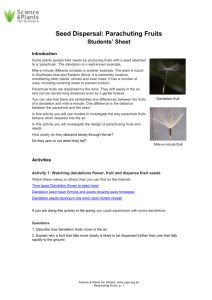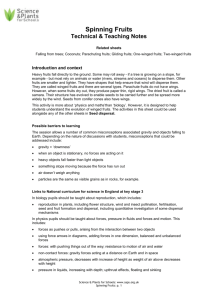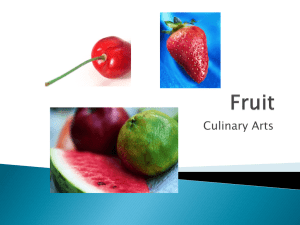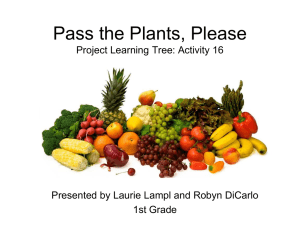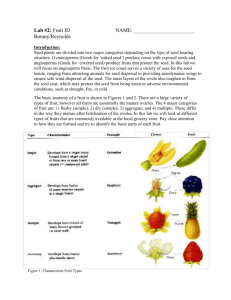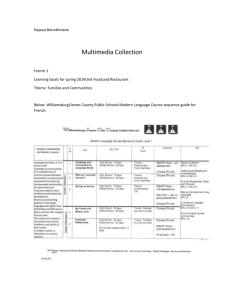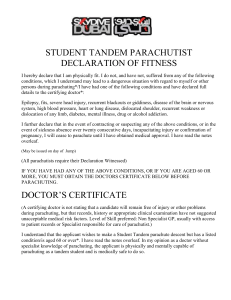3 Parachuting fruits - teachers notes
advertisement
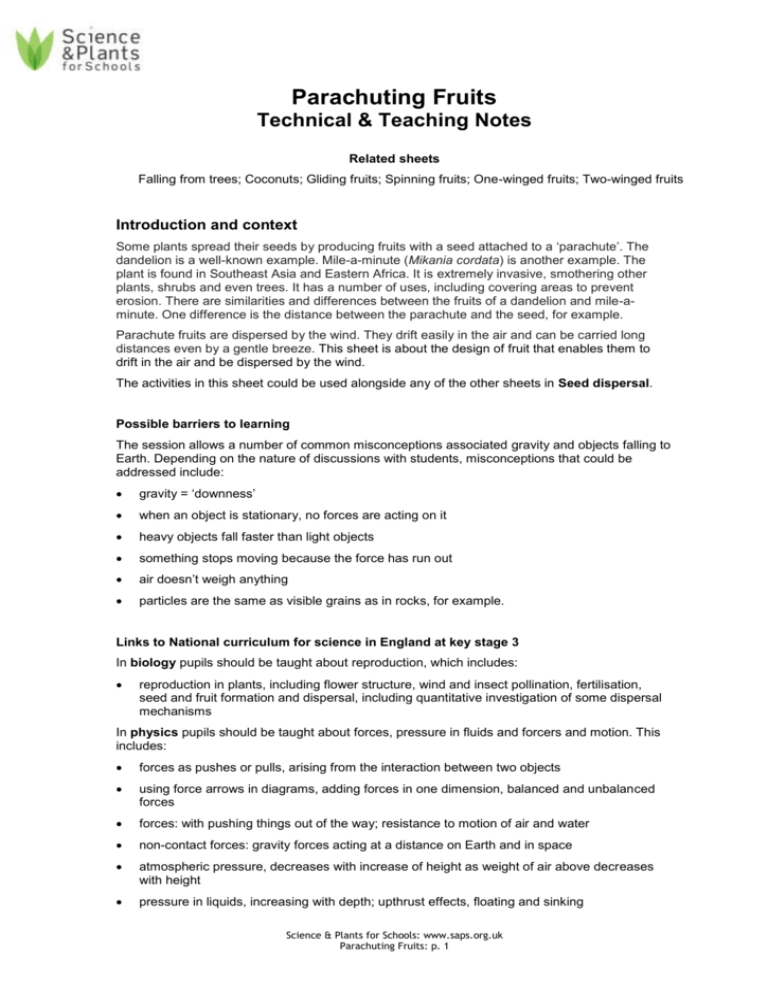
Parachuting Fruits Technical & Teaching Notes Related sheets Falling from trees; Coconuts; Gliding fruits; Spinning fruits; One-winged fruits; Two-winged fruits Introduction and context Some plants spread their seeds by producing fruits with a seed attached to a ‘parachute’. The dandelion is a well-known example. Mile-a-minute (Mikania cordata) is another example. The plant is found in Southeast Asia and Eastern Africa. It is extremely invasive, smothering other plants, shrubs and even trees. It has a number of uses, including covering areas to prevent erosion. There are similarities and differences between the fruits of a dandelion and mile-aminute. One difference is the distance between the parachute and the seed, for example. Parachute fruits are dispersed by the wind. They drift easily in the air and can be carried long distances even by a gentle breeze. This sheet is about the design of fruit that enables them to drift in the air and be dispersed by the wind. The activities in this sheet could be used alongside any of the other sheets in Seed dispersal. Possible barriers to learning The session allows a number of common misconceptions associated gravity and objects falling to Earth. Depending on the nature of discussions with students, misconceptions that could be addressed include: gravity = ‘downness’ when an object is stationary, no forces are acting on it heavy objects fall faster than light objects something stops moving because the force has run out air doesn’t weigh anything particles are the same as visible grains as in rocks, for example. Links to National curriculum for science in England at key stage 3 In biology pupils should be taught about reproduction, which includes: reproduction in plants, including flower structure, wind and insect pollination, fertilisation, seed and fruit formation and dispersal, including quantitative investigation of some dispersal mechanisms In physics pupils should be taught about forces, pressure in fluids and forcers and motion. This includes: forces as pushes or pulls, arising from the interaction between two objects using force arrows in diagrams, adding forces in one dimension, balanced and unbalanced forces forces: with pushing things out of the way; resistance to motion of air and water non-contact forces: gravity forces acting at a distance on Earth and in space atmospheric pressure, decreases with increase of height as weight of air above decreases with height pressure in liquids, increasing with depth; upthrust effects, floating and sinking Science & Plants for Schools: www.saps.org.uk Parachuting Fruits: p. 1 forces being needed to cause objects to stop or start moving, or to change their speed or direction of motion (qualitative only) change depending on direction of force and its size Safety Notes Make sure that students handle scissors, compasses and other sharp objects carefully. Also, toothpicks can be sharp. You need a place where the models can be tested by dropping from 2m or more, especially if students are timing the descent. Equipment and materials Each student or group will need: access to the Internet (this part – watching videos – could be done at home) 3 or 4 sheets of A4 paper pencil and ruler a compass or other ways to draw circles (such as plastic cups of lids) scissors 2 toothpicks (or similar) plasticine or BlueTak sticky tape optional: (a) stopwatch to time descents, (b) smartphone/digital camera to video the descent Teaching Notes Activity 1: Watching dandelions flower, fruit and disperse their seeds There are many videos on the Internet. Those in slow motion are particularly useful in allowing students to use and develop their observational skills. Answers 1. The fruits drift in the air, the speed at which they drift depends on the strength of the wind. They descend slowly to the ground. 2. The slower the fall the greater the chance that the fruit will be blown by the wind and carried away. Activity 2: Two alternative models of parachute fruit Both models are straightforward to make to make. Students should take care when cutting the paper for model 1. The dimensions given are not critical, but they do produce a model seed that works well. The circle for model 2 should be cut out carefully, but it is not critical to get a perfect circle. Students may need some guidance in folding the paper circle (it is the same technique as folding a filter paper to make a fluted funnel). You could ask students to try it with and without the ‘seed’ Science & Plants for Schools: www.saps.org.uk Parachuting Fruits: p. 2 on the bottom of the toothpick – without it the parachute sways from side to side as it descends. With it, the parachute descends slowly without much, if any, swaying. Answers 1. Model 1 falls slowly and spins – the strips of paper act as ‘wings’. Students will learn more about this when they investigate winged fruit. Model 2 descends slowly and gracefully, with no spinning. 2. Model 2 is the better model because, like the dandelion fruit, it does not spin in the air. The tiny hairs of the dandelion act like a single canopy rather than lots of tiny wings. Activity 3: Investigating parachute design The investigation of variations to the design of model 2 takes time, but it reinforces ideas about gravity and air resistance and factors that affect fall (descent) time. Answers 1. Students are likely to discover that parachute with a large surface area fall more slowly than those with smaller surface areas. If the mass on bottom of toothpick is too small, the parachute will sway as it falls; too large and the parachute may not work at all unless its surface area is much greater. 2. It is important to stress that students are not expected to arrive at aeronautical explanations! However, they should be able to use their ideas about gravity, the arrangements and movement of particles (in solids and gases), and air resistance to understand what is happening and why parachute fruits look the way they do. Activity 4: The effect of wind Wind is the key to wind dispersal of fruits and the seeds they carry. Answers 1. Wind is the flow of air particles from a region of high pressure to one of low pressure. This is a type of diffusion. 2. air resistance air particles moving from high to low pressure wind gravity ground 3. The movement depends on the relative magnitudes of the three forces acting on the falling object. The faster the air particles in wind move, the larger the force they exert on the falling object. Science & Plants for Schools: www.saps.org.uk Parachuting Fruits: p. 3
